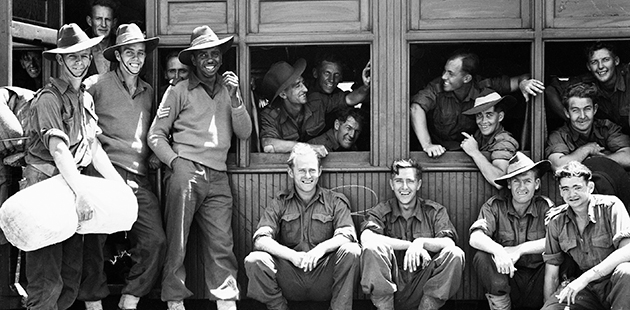 On display at Melbourne Museum from 11 August 2018, For Country, for Nation is a multidisciplinary touring exhibition, developed by the Australian War Memorial, that explores stories of Aboriginal and Torres Strait Islander military service.
On display at Melbourne Museum from 11 August 2018, For Country, for Nation is a multidisciplinary touring exhibition, developed by the Australian War Memorial, that explores stories of Aboriginal and Torres Strait Islander military service.
Taking visitors through six non-linear thematic sections, For Country, for Nation relates military service stories from the perspective of Australian First Nations people – many which are presented in first-person voice.
Developed in collaboration with respected Aboriginal consultant curator Amanda Jane Reynolds, collaboration occurred with individuals, artists, families, communities and key Elders and Knowledge Holders. Community collaboration was at the heart of this exhibition’s development, with the aim of raising awareness about the valuable and selfless military contributions of Australian First Nations people.
Over 200 objects, photographs and artworks are accompanied by dance, song, and sound, resulting in compelling connections between visual and aural storytelling. Viewers will experience a large-scale projection of the ‘Sarpeye’ war song and dance performed by Charlie Company, 51st Battalion, Far North Queensland Regiment; the first time that this dance has been recorded.
Central objects within For Country, for Nation are two specially-commissioned works by Aunty Clair Bates and Aunty Glenda Nicholls – whose peaceful mixed-media piece invites visitors to contribute a personal offering of remembrance – a poppy, a blessing, or a small keepsake.
Other specially-commissioned artworks from First Peoples artists Andrew Snelgar, Vicki West, Gabriel Nodea, Patrick Freddy Puruntatameri, Tony Albert and Marilyne Nicholls interpret and respond to First Peoples military experiences. Displayed alongside these are works by Gordon Bennett, Albert Namatjira, Jimmy Pike, Julie Dowling, Daniel Boyd, Shirley Macnamara and many more.
“For Country for Nation tells the stories of Aboriginal and Torres Strait Islander peoples service in Australia’s military forces that are rarely given a public voice,” said Dr. Shannon Faulkhead, Acting Deputy Director of First Peoples at Museums Victoria. “It is with great pride that we see the contributions of Indigenous service men and women recognised in such a beautiful and powerful exhibition.”
The themes contained within For Country, for Nation echo Museums Victoria’s commitment to placing First Peoples’ living cultures, histories and knowledge at the core of its practice.
Australian War Memorial Director Dr Brendan Nelson said For Country, for Nation is one of the most significant exhibitions developed by the Memorial in recent times. “It is hard for non-Indigenous Australians to imagine the world as Indigenous Australians saw it, but we must,” he said.
“They have served in every conflict this country has engaged in and they continue to do so with pride and professionalism, which is nothing short of inspiring. This exhibition is an opportunity to honour their service.”
For Country, for Nation sits thematically between two other exhibitions currently showing at Melbourne Museum, that explore hardship, determination, and sacrifice – WW1: Love & Sorrow tells eight very different World War One stories through over 300 photographs and objects.
Because of Her, we can! showing in the Birrarung Gallery at Bunjilaka Aboriginal Cultural Centre, relates the stories of Victorian First Peoples women who made great impacts in their communities, particularly in the establishment of Aboriginal run services.
For Country, for Nation
Melbourne Museum, 11 Nicholson Street, Carlton
Exhibition: 11 August – 7 October 2018
Free admission (after museum entry)
Information: www.museumsvictoria.com.au
Following its display at Melbourne Museum, For Country, for Nation will tour across Australia until 2021. For more information, and exhibition dates, visit: www.awm.gov.au for details.
Image: Troops of the 2/7th Infantry Battalion in the carriages and on the station platform waiting for the south-bound leave train to start – courtesy of Australian War Memorial
